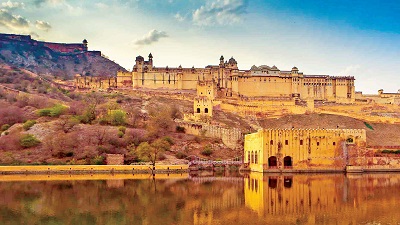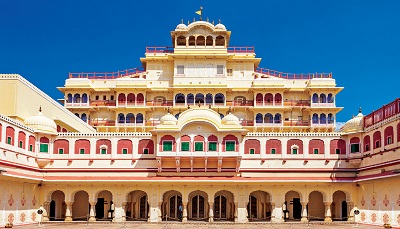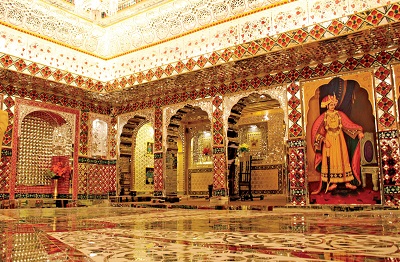The Architectural Marvels of the Pink City

Despite its reputation as the ‘Pink city’, Jaipur offers its visitors every shade of Nature’s palette: rich amber hues of the desert sunset, gleaming edifices and vibrant gemstones in any colour you can imagine. History comes alive as the city continues to inspire creative artists of every field.
Brimming with rich, varied culture, Jaipur has the power to take you on an enchanting journey where you will encounter royal Kings and their brave conquests, lavish palaces decorated with dazzling jewels and precious stones, majestic fortresses with stunning hand carvings and picturesque views of this UNESCO World Heritage site. An invigorating mix of the past, present and future, this enigmatic city has hospitality deeply entrenched in its mindset
and is on every tourist’s bucket list. No matter which time of the year you visit Jaipur, it is sure to wow you with its stunning beauty that has stood the test of time.
Founded by the ruler of Amer, Maharaja Sawai Jai Singh in 1727, Jaipur was painted in pink in 1876 to welcome Prince Albert and Queen Elizabeth II. Believing that the colour denoted hospitality and warmth, thus began the lifelong association of the colour pink and Jaipur. With a keen interest in Arts and crafts, prior rulers invited skilled artisans, artists and craftsmen from across India and abroad who settled in the city. As a result, Jaipur has become a melting pot of cultures and attracts millions of tourists every year. The city is packed with handicrafts, traditional artifacts and marketplace is lined with abundant shops offering colourful, traditional dresses, hand woven fabrics, tiny replicas of marbled monuments and many more souvenirs.
World famous for its coloured gemstones, Jaipur is home to innumerable gem cutters who deal in both precious and semi precious stones of various shades. Here you can marvel at the deep red rubies and royal green emeralds, iridescent pearls along with brilliant white diamonds. Another classic craft is the intricate meenakari work done exclusively in Jaipur. This consists of coloured ivory designs embedded along with gilded metal in different pieces of jewellery. The finesse and craftsmanship of these artisans is awe inspiring and is passed on through generations.

Built in 1835, Rambagh Palace has seen a number of inhabitants. From the queen’s favourite handmaiden, to royal guesthouse and hunting lodge, and later as the residence of the Maharaja Sawai Man Singh II and his queen, Maharani Gayatri Devi. Today, it has been converted to a luxury hotel managed by the Taj Group and is one of Jaipur’s crowning jewel. It showcases the best of Rajasthan’s architecture with its hand-carved marbled latticework, resplendent gardens and opulent fine dining restaurants. The palace also offers a heritage walk to gain insightful anecdotes on the royal life of the Maharaja.
The beguiling beauty of red sandstone and white marble is what makes the Amber Palace Jaipur’s star attraction. Located at the foothills of the Aravalli Range, the foundation of the palace was laid by Raja Man Singh I and was completed by Mirja Raja Jai Singh. Strategically built, the sheer level of skill, mastery and intricacy of the palace’s interiors is spell bounding. The captivating beauty of the Sheesh Mahal is apparent with its glittering mirrors which illuminates the room with even a single ray of the sun. Marvel at the white marble pillars of Diwan-e-Aam which features fabulous hand carved designs embedded with floral glass inlay and semi precious stones. With forty pillars in total, each pillar gives a glimpse of the lifestyle of yesteryears. Kings and Maharajas used to use the Diwan-e-Aam to receive members of general public and hear their grievances.

An iconic structure of Jaipur, Hawa Mahal was built by Maharaja Sawai Pratap Singh in 1798. A five stored, red sandstone extension representing a honeycomb, this building is truly one of its kind. It has 953 small windows, called jharokas and is similar to the crown of Lord Krishna. In order to protect the dignity of women, this building was designed in a way that its habitants could get a clear view of the streets below, but laymen could not view them from the streets. Irrespective of the season or time of the year, the Hawa Mahal will always receive the cool, refreshing breeze thus becoming the favourite summer destination of the Royal family and rightly referred to as Palace of the Winds.
An amalgamation of Rajputana and Mughal styles of architecture, The Jal Mahal is located at the centre of the Man Singh Lake. This five story palace has four stories submerged in the lake when it is filled, giving the impression of a floating palace. Accessible by boats, The Jal Mahal is also home to various indigenous birds like Flamingo, Great Crested Grebe, Pintail, Kestrel, Coot and Grey Wagtail.
As one of the best theorists in ancient India, Maharaj Sawai Jai Singh built five astronomical instruments to study outer space. These instruments are known to us by the name of Jantar Mantar meaning Calculating Instruments. Consisting of fourteen geometric devices that measure time, predict eclipses, track the location of stars and the Earth’s movement around the sun, Jantar Mantar has been declared a World Heritage Site by UNESCO. Every glimpse of Jaipur is postcard worthy and has been immortalized in the pages of history through songs, dance, books, films and television. An enticing blend of luxury, history and modernity, this remarkable Rajasthani city will leave you with unforgettable memories that will surely last for a lifetime.
Be the first to comment